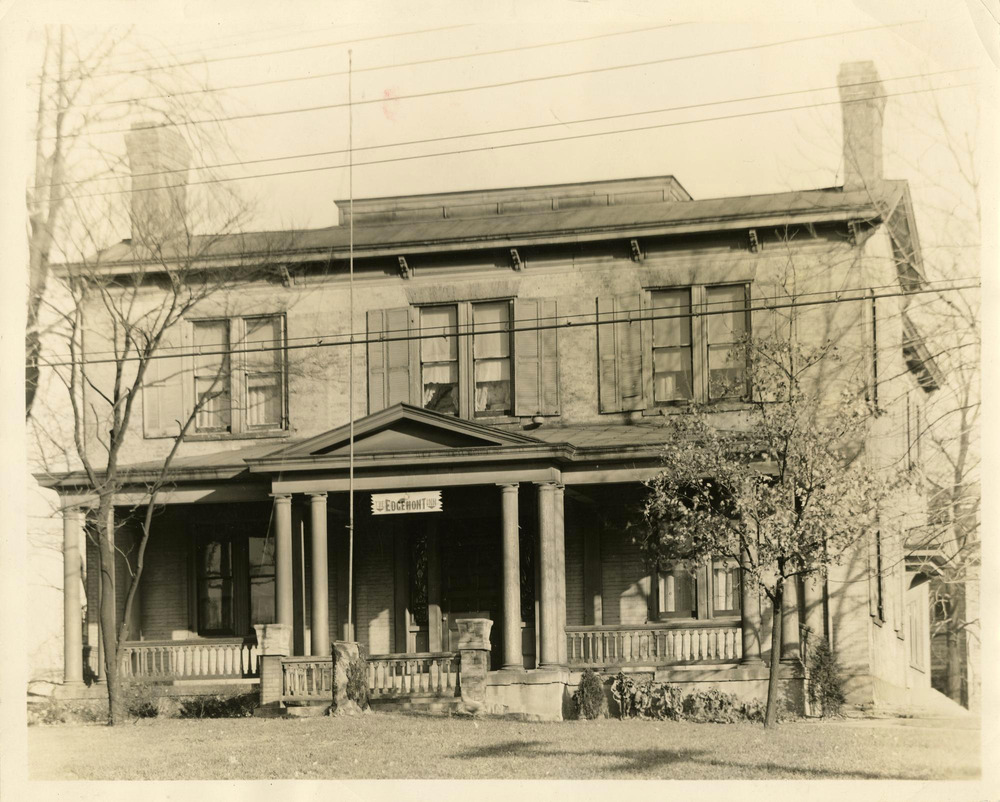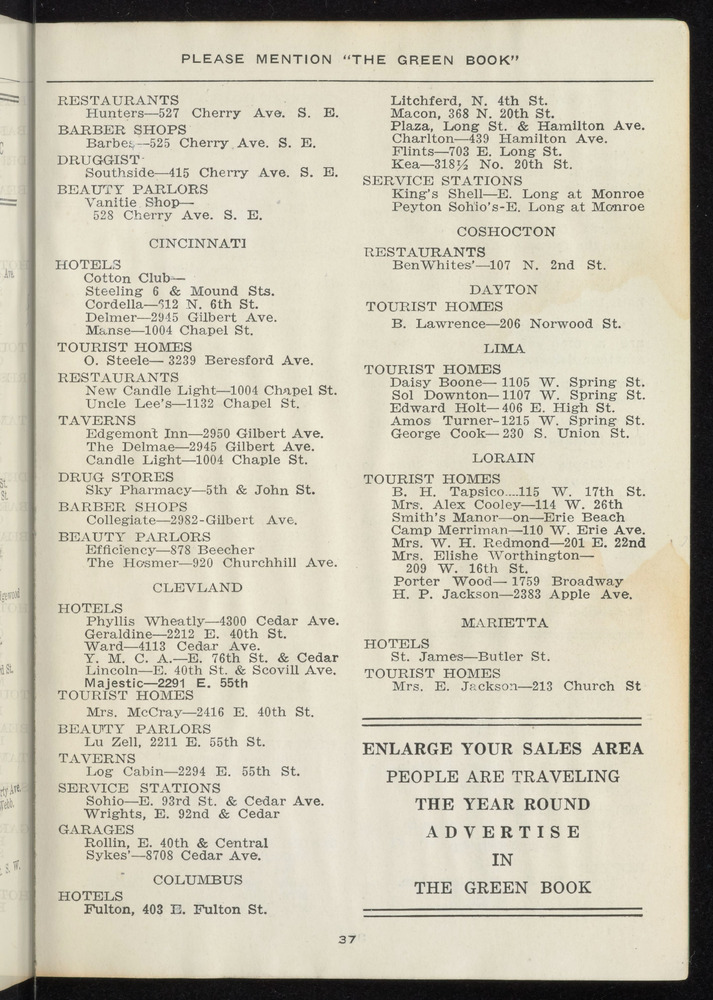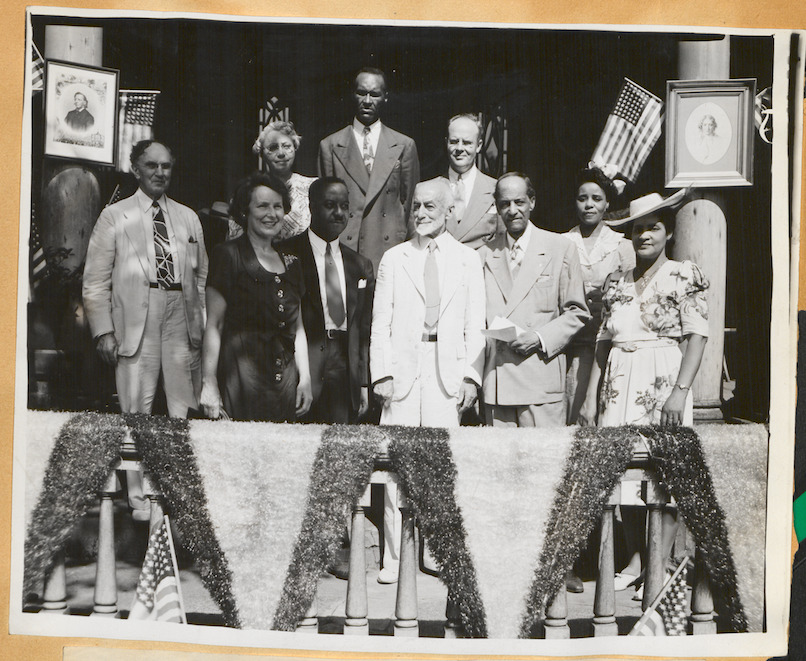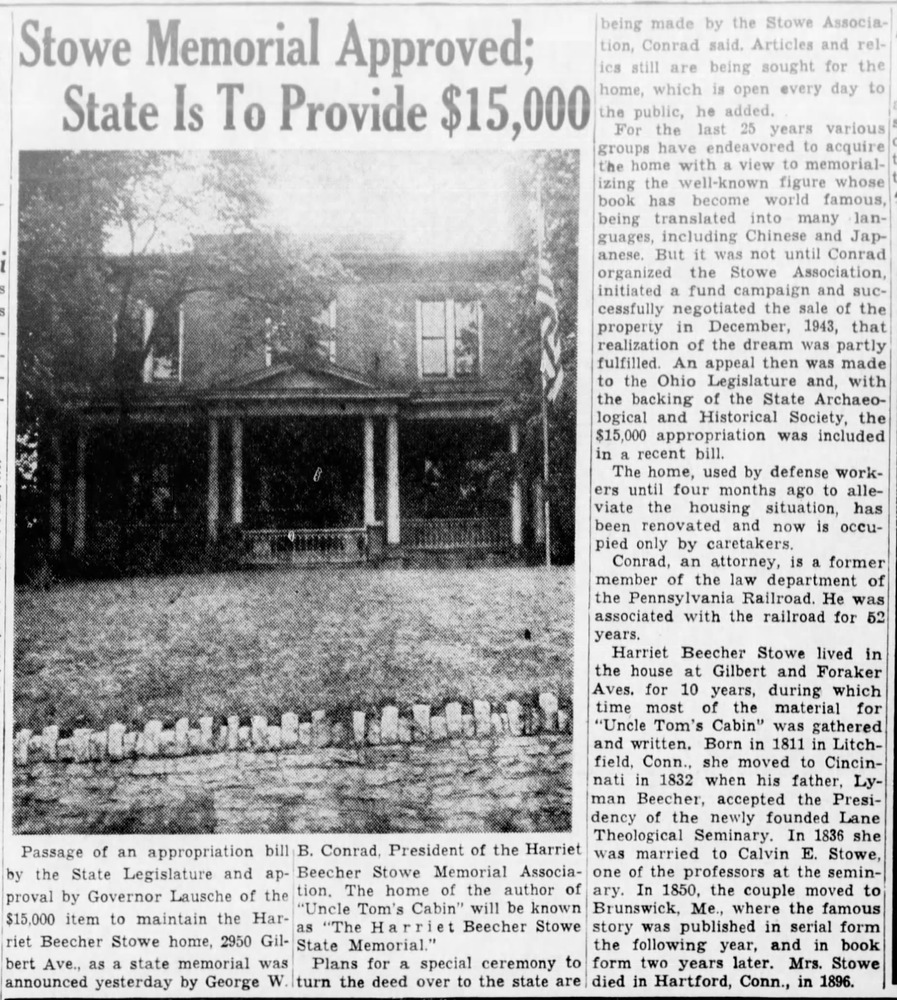The Edgemont Inn
A tavern and boarding house listed in the "Negro Motorist Green Book".

Showcasing a little-known history of the Harriet Beecher Stowe House as Edgemont Inn, an extant former Green Book site in Walnut Hills.
About the Green Book Site
As the Edgemont Inn, the first floor was a tavern space. It was listed in the Green Book and served a wide group of Black patrons. Upper floors served as an African American boarding house operated by a Black woman named Mrs. Irene Bacon. By this time, the house was already a landmark of the abolition and suffrage movements (as Harriet Beecher Stowe's former home), and visitors of the Edgemont Inn were aware of its history as home to the Beecher family a century earlier. As the Edgemont Inn, it was a place for discussion and action in a new chapter of Black freedom and a safe gathering and living space for African Americans in the segregated landscape in Cincinnati.
The Edgemont Inn was located within the epicenter of a Black neighborhood. Walnut Hills has been one of the African American enclaves in Cincinnati. While Walnut Hills had been integrated in the 1800s, since the 1920s, the Black portions of the neighborhood expanded due to Cincinnati's rapidly increasing African American population. Also, the Edgemont Inn was a convenient place to access public transportation.
The Edgemont Inn was located on Gilbert Avenue, the main street that connected the hilltop and downtown. Peebles' Corner, a famous streetcar intersection on Gilbert Avenue and East McMillan Street, was only a few blocks south from the house. The house a safe and comfortable place for African Americans to access and stay in. It was located within the Black business district, centered at Lincoln and Gilbert Avenues. The surrounding area had several neighborhood institutions, such as the Manse Hotel, a landmark accommodation for African Americans, and the headquarters of the Cincinnati Federation of Colored Women's Club. A few blocks Southeast, there was the Frederick Douglass school, a public school serving African American children, and the Brown Chapel, an AME church.
As a Tavern
After the Beecher family moved out of the house in the early 1850s, other Lane Seminary professors lived there for a time. Joseph G. Monfort purchased the house in 1865. The building went through several renovations over the generations of Monfort family members. The last Monfort resident, Mary E. Monfort, moved out of the house in 1930. She and her sister continued to own the property until 1943. They leased it to the tavern and boarding house proprietors. As early as 1932, the house drew public attention as Harriet Beecher Stowe's former home and hosted private parties. Before the house was known as the Edgemont Inn, it was called Pleasant View Hotel in 1933 and 1934. The advertisement below shows the hotel had "reasonable rates" and provided "courteous service" with a "good beer on tap."
As a Green Book Site
By 1935, the house at 2950 Gilbert was called the Edgemont Inn. The Black community used the space for various occasions; a linen shower for a wedding on a Friday afternoon with "a most delightful refreshing dinner," a birthday party, an evening party with four-course meal, a dancing party on New Year's Eve, and a lovely breakfast party. People enjoyed dancing and card games at the Edgemont Inn and sometimes went down to the Cotton Club, a famous nightclub in the West End.
From 1939 to 1952, the Edgemont Inn was listed under the tavern section in the Negro Motorist Green Book. It was a traveling guidebook listing safe lodging, restaurants, and other accommodations for African American tourists and businessmen. Considering that the Edgemont Inn turned into a historic site by 1946, its continued inclusion in the late 1940s and early 1950s was potentially an administrative lag at the publishers.
Civic Organizations
During Jim Crow segregation, Black Cincinnatians experienced discrimination and racial inequality that limited their access to public venues, vocational and professional training, education, and medical care. As such, the Edgemont Inn became a space for meetings where community leaders and associations gathered and discussed cultural, social, and political issues Black citizens confronted in their everyday lives in the 1930s.
The Brotherhood of Sleeping Car Porters (BSCP) was a nationwide labor union seeking to improve the working conditions and treatment of African American workers. The BSCP interacted with Cincinnati porters since 1926, when the BSCP organizers traveled to the cities in the Midwest to crusade their mission. The organizer recorded that they recruited "quite a number of local porters" in Cincinnati. Although the Cincinnati chapter was not visibly active on the records, they were part of the national labor movement.
The Edgemont Inn hosted the Cincinnati chapter's first grand social party in 1935. Participants enjoyed a card game and dancing. On September 21 to 23, 1936, the BSCP held its fourth annual convention at the Edgemont Hotel in Cincinnati, with delegates from all over the nation representing more than the 6,000 members of Pullman porters and maids. During the convention, the BSCP revealed their endorsement of the steelworkers union and the Farmer-Labor party. The BSCP reassured their views against fascism, war, and Jim Crow segregation.
The National Association of College Women, today known as the National Association of University Women , was established in Washington D.C. in November 1924 to stimulate the professional lives of young Black women who graduated from universities and colleges. While it is unknown when the Cincinnati Chapter was founded, the branch consisted of notable Black female professionals in Cincinnati; Dr. Jennie D. Porter, a president of the Cincinnati Chapter, was a pioneer of Black public education in Cincinnati. Dr. Lucy Oxley, the first African American graduate from the U.C. Medical College in 1936, was also a member of the National Association of College Women in Cincinnati.
On February 12, 1936, under the presidency of Mrs. Jessie G. Davis, who was a vocational counselor at the Stowe School, the Cincinnati Branch used the Edgemont Inn to hold a Lincoln's Birthday bridge party. From April 10 to 13 in 1936, the Cincinnati Branch hosted the Association's 13th annual convention for three days in Cincinnati. The Edgemont Inn became a venue for a second-day session, including business meetings in the morning and luncheon sessions. After the session, participants enjoyed an annual banquet at the Manse Hotel, two blocks from the Edgemont Inn.
The Cincinnati Medical Association , still in existence today, is a local chapter of the National Medical Association, the oldest and largest organization of African American physicians and health professionals. The Cincinnati Medical Association led the local operation of the National Negro Health Week. Observed in the first week of April, National Negro Health Week aimed to improve the African American population's public health by educating the community, providing access to healthcare, and assisting the growing number of black medical professionals. In 1936, the members of the Cincinnati Medical Association gathered several times at the Edgemont Inn for their regular meeting on Thursday evenings.
Cincinnati embraced several public health associations in the 1930s and built a reputation as a public dental health center among the major cities in the U.S. On February 23, 1935, the members of the Ohio Valley Dental Society visited the Edgemont Inn and honored Dr. Chas Schooley, a dean of the Society, for his 37 years of dental practice. When the Ohio Valley Dental Society hosted the 23rd Convention of the National Dental Association in 1936, the Executive Committee gathered at the Edgemont Inn to plan that convention. National Dental Association was a nationwide network of African American dentists, and the convention was held at the University of Cincinnati from August 4 to 7, 1936, anticipating 200 participants from all over the country.
Political rallies and meetings
Throughout the late 1930s and early 1940s, the Edgemont Inn hosted a number of political rallies and meetings. Embracing the tavern space and boarding house on upper floors, the house was sometimes called the "Edgemont Hotel" in local newspaper articles like those listed below.
Oct 15, 1935: Dr. Glenn Adams, a Republican candidate for reelection to Council, participated in the meeting of Ninth Ward Negro Republicans at the Edgemont Hotel.
Oct 17, 1935: The executive committee for the campaign for Dr. Richard P. McClain held a supper at the Edgemont Inn for the workers.
Oct 24, 1935: George W. E. Conrad, an independent candidate for Council, held his campaign committee meeting at the Edgemont Hotel. George W.E. Conrad later became a President of the Harriet Beecher Stowe Home Memorial Association.
May 11, 1936: Democrats held a final meeting for the congressional campaign of Edward C. Hauer at the Edgemont Hotel.
Oct 14, 1938: The meeting of the Ninth Ward Democratic Club was held at 2950 Gilbert Avenue.
Nov 2, 1939: John W. Barrett, an independent candidate for the Board of Education, held his rally at the Edgemont Hotel and criticized the present board's expenditure.
Sep 26, 1941: Laurent Lowenburg and Edward H. McReynolds, both Charter candidates for Council, spoke at the meeting of the Ninth Ward Democratic Club and its Women's Auxiliary.
Jul 31, 1942: John M. Baker, Democratic candidate for the First District congressional nomination, addressed his speech at the Ninth Ward Colored Democratic Club at the Edgemont Inn.
Oct 18, 1942: A meeting of the Negro Democratic organizations of the county was held in the evening sponsored by the Hamilton County Council of Democratic Clubs.
The Edgemont Inn as a Boarding House
The house's large number of rooms on the upper floors was a good space for several Black individuals and families to stay. According to the 1940 U.S. census, 19 African American residents lived in the house. From 1941 to 1948, the house was listed as the "Edgemont Apartment '' with 12 rooms in the city directories.
On April 23, 1942, the Cincinnati Enquirer reported one room in the house known as "the Edgemont Hotel" sustained minor damage with a loss valued at $100. Earl Williams, age 4, and William Williams, age 3, admitted to starting the fire by stuffing matches under the floorboards. Mrs. Irene Bacon was listed as the operator of the Edgemont Inn.
Female-operated boarding houses were common during the segregation era. Rather, it provided financial and political opportunities for African American women. In Mrs. Bacon's case, operation may have encouraged her to engage in politics. Irene Bacon was listed as one of the women's campaign committee leaders for Edward H. McReynolds, a Black democratic candidate for City Council in 1941.
Irene and Thomas Bacon
Irene Bacon, maiden name Carter, was born on April 1, 1894, in Cincinnati, Ohio. By 1930, Irene met her future husband, Thomas Bacon. On August 6, 1930, Irene and Tom married in Cook County, Chicago, Illinois. The record shows that almost one month after their marriage, Irene and Thomas lost a baby boy by stillbirth and buried him in the Oak Forest Cemetery in Chicago.
Irene Bacon moved to Cincinnati in 1935 and started renting rooms in the Edgemont Inn. Tom moved to Cincinnati around 1938 and worked as a bartender and cook in a railroad dining car. Irene and Tom lived in Room 1 in the house until 1946, when they moved across the street to 2947 Gilbert Avenue. On November 16, 1948, Tom passed away and was buried in the United Colored American Cemetery on November 20, 1948. The City Directory shows Irene Bacon lived in 2947 Gilbert until 1951. Irene Bacon passed away on March 17, 1955.
John and Carrie Stewart
John Stewart and his wife Carrie Stewart were long-term residents of the Edgemont Inn. Before they lived in the house, the Stewarts lived at 2519 Burnet Avenue, where John's father, Henry Stewart used to own the house. According to the 1930 U.S. Census, John Stewart, age 65, his occupation was a fireman. In 1935, Carrie Stewart moved into the Edgemont Inn, and John Stewart moved into the house around 1937.
John Stewart’s name appeared in the newspaper due to the sentence he received in 1937. John was arrested at Park and Foraker Ave after he struck a parked car and failed to stop. He received a three-day workhouse sentence and his right to drive was suspended for a year.
In the 1940 U.S. Census, John was 79 years old and the oldest among 19 residents in the Edgemont Inn. Carrie was recorded as 70 years old. John and Carrie lived in Room 2 until 1943, when John passed away at 82. After John's death, Carrie seemed to have moved out of the house. Carrie passed away on January 6, 1948, at 77.
Williams family
Earl Williams Jr. and William Williams were sons of Earl Edward and Georgia Williams. The family was living on the third floor, where the evidence of the fire still remains in the north closet of the attic. Earl and Georgia had three sons. Their first son, John Penn, was born in 1935, followed by Earl Williams Jr. in 1937. In 1940, Williams' family was recorded as residents of the house as a family of five, including a 10-month baby Charles Williams, also known as William Williams.
According to the city directory, the Williams family lived in Room 12 in 1941 and 1942. We believe that number corresponds to the attic space. The family moved out after the incident that their children caused, and lived at 2935 Gilbert Avenue in the 1950s.
From House to Museum
The idea of purchasing and preserving the house came true when George W. E. Conrad, an African American attorney of the Pennsylvania Railroad for 50 years and the President of the National Catholic Interracial Federation, learned a rumor that “certain unscrupulous persons” were planning to purchase the house and convert it into a nightclub. Worried about the future of this historical asset, Conrad and other community leaders met at the Ninth Street YMCA on February 7, 1943 and addressed the need to purchase the house. Conrad was elected President of the Harriet Beecher Stowe Home Memorial Association. Other executive committee members included J. W. Scott, Vice President; Elmer Hunsicker, Treasurer; Miss Sadie Samuels, Recording Secretary; Miss Dorothy Gillam, Correspondence Secretary; and Judge Stanley Struble, Consultant.
The Memorial Association initiated the fundraising and lobbying campaigns to purchase the house for establishing "a shrine and museum to make the Hariett Beecher Stowe House and Edgemeont in a cultural center." Sadie Samuels, a secretary of the Association and a teacher at the Frederick Douglass school, played an instrumental role in fundraising, in which she and co-workers raised $6,000 in three months. In December 1943, the Memorial Association purchased the property from Mary E. Monfort for $8500. In 1946, the Memorial Association transferred the house to the Ohio State Archaeological and Historical Society (today known as the Ohio History Connection), and the house became a state historic site.
Conclusion
The Edgemont Inn period shows a little-known chapter of the history of the Harriet Beecher Stowe House. From 1930 to the late 1940s, the house transitioned from a residence to a community gathering space associated with a communal dwelling. Through this transition, the house provided a safe space to gather, discuss, and live for African American communities in the segregated urban landscape. The space has been used for Black social, political, and professional groups to present their Power of the Voice to make positive changes in their community.
Images



